There is an opinion that nail fungus is a purely aesthetic problem and should not be harmful to human health. This position is extremely incorrect, as the toxins produced by the pathogenic fungi get into the bloodstream and cause poisoning in the body and can have very serious consequences. In addition, a sick person is a source of infection and can infect many others.
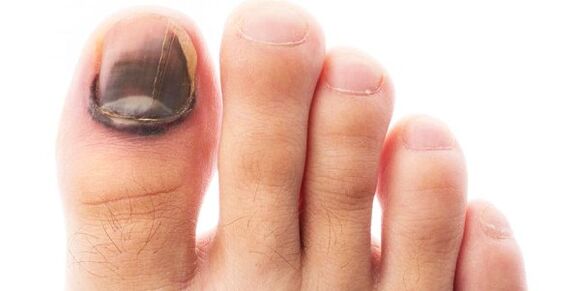
Reasons for appearance
Onychomycosis - a fungal infection of the nail plates on the legs or arms - is most common in people who lead an active lifestyle: visiting swimming pools, gyms, spas, vacationing at beach resorts.
When applied to the skin and nails of a person with strong immunity, the spores of the fungus are in a latent state for some time. Their transition to development and reproduction may be due to the following factors:
- weakening of the body's defenses due to viral diseases,
- diabetes mellitus, hypothyroidism and other endocrine diseases,
- stressful states, excessive nervous and emotional excitement,
- varicose veins of the lower extremities, which interfere with normal blood circulation,
- bruises, abrasions, cracks and other injuries to the feet and nails,
- long stay in closed shoes, which leads to increased sweating,
- wearing synthetic stockings or socks,
- metabolic disorders, obesity,
- non-compliance with personal hygiene rules.
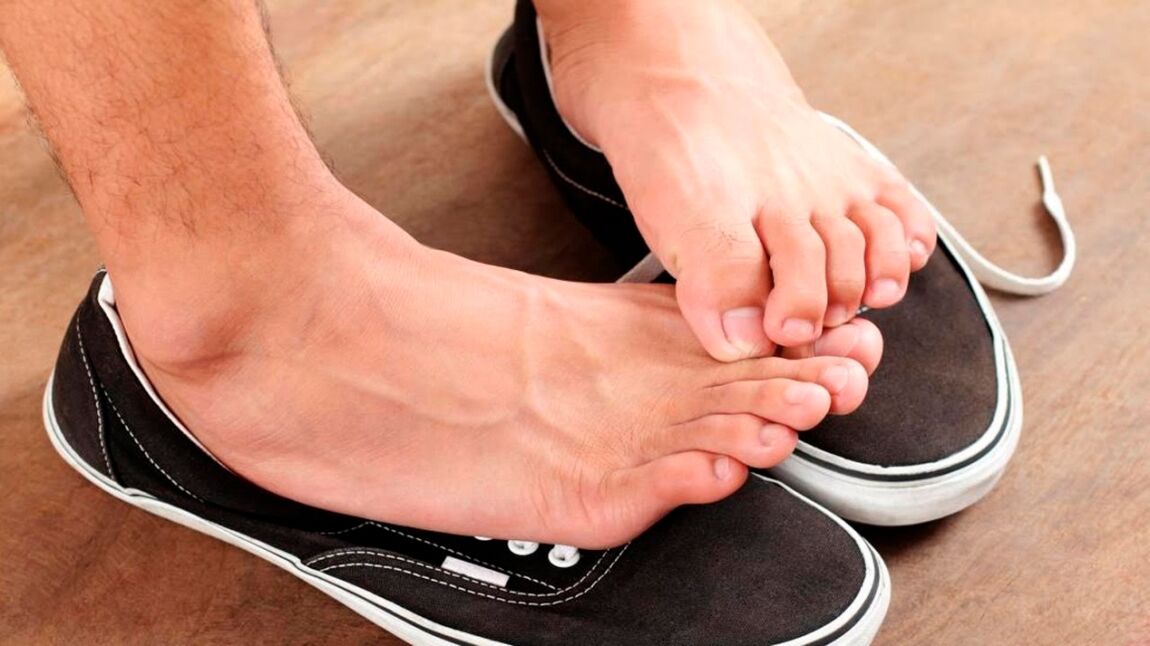
The risk group includes patients with chronic pathologies of the internal organs - kidneys, liver, bile ducts, as well as patients taking long-term antibiotics, hormonal drugs, including birth control pills.
Types of onychomycosis
There are more than 500 opportunistic fungi that can parasitize on human skin and nails.
The most common causes of onychomycosis are:
- Dermatophytes. These include fungi such as Trichophyton, Microsporum and Epidermophyton. The disease begins on the nail plates and, if left untreated, spreads to the entire foot.
- Candida yeast. In most cases, the infection occurs in places with high humidity - in saunas, baths or swimming pools.
- Mold whose main sign of defeat is a change in the color of your nails - from dirty green to brown and black.
The fungi first affect the fingernail and then move on to the others, least to the little finger. All types of onychomycosis are accompanied by severe itching in the interdigital zone, burning and an unpleasant rotting odor caused by the breakdown of fungal waste products.
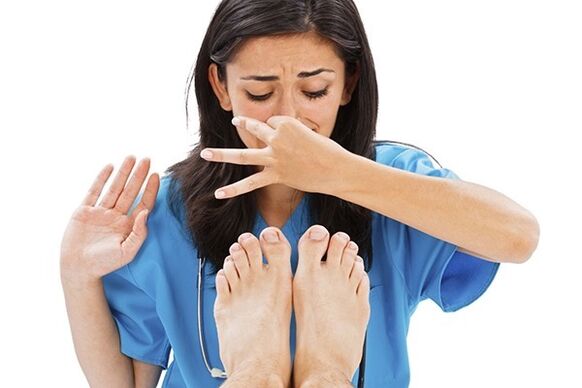
Stages of the disease
Any type of fungus requires medication. Prior to appointment, the physician should understand the stage of the disease and determine the extent of damage to the nail plate.
Depending on the clinical picture, the following stages of onychomycosis can be distinguished:
- Normotrophic - the initial stage of the disease in which the nails gradually change color, showing spots and streaks on them. The nail plate still retains its normal shape, thickness and healthy shine.
- Hypertrophic. The nail thickens, becomes dull and brittle, crumbling along the edges. The patient feels pain when walking in tight shoes.
- He is atrophic. According to the name of the stage, the nail is quickly destroyed, bent and separated from the nail bed. The plate becomes very thinner and brownish spots appear beneath it - foci of pathogen invasion. Eventually the nail breaks off completely.
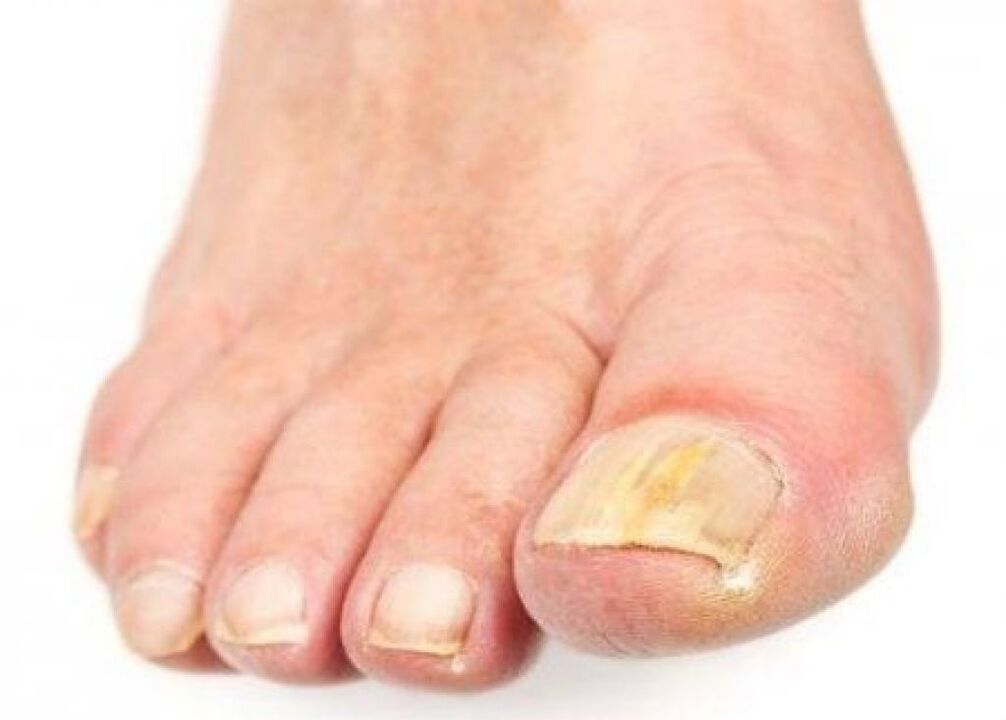
The more advanced the disease, the longer and harder it is to get rid of it. If onychomycosis in the initial normotrophic stage can be cured using conventional medicine, the removal of the affected nails by surgical methods is often required in the final stages.
Symptoms
In order to start treatment in time, it is necessary to understand how onychomycosis of the nails manifests itself in each stage.

In the initial stage, the main signs of nail fungus are reddening of the skin in the interdigital zone, accompanied by mild exfoliation and itching. After that, the symptoms of a fungal infection develop in the following order:
- the nail fold becomes red, swollen and painful,
- the color of the nail changes from dirty yellow to black, depending on the type of pathogen,
- spots, grooves, tubers and streaks appear on the surface of the disc,
- the nail thickens and peels,
- white mass accumulates in the subungual space, giving off an unpleasant odor,
- the keratinized nail plate starts to crumble along the edges,
- the nail completely peels off the bed and is rejected.
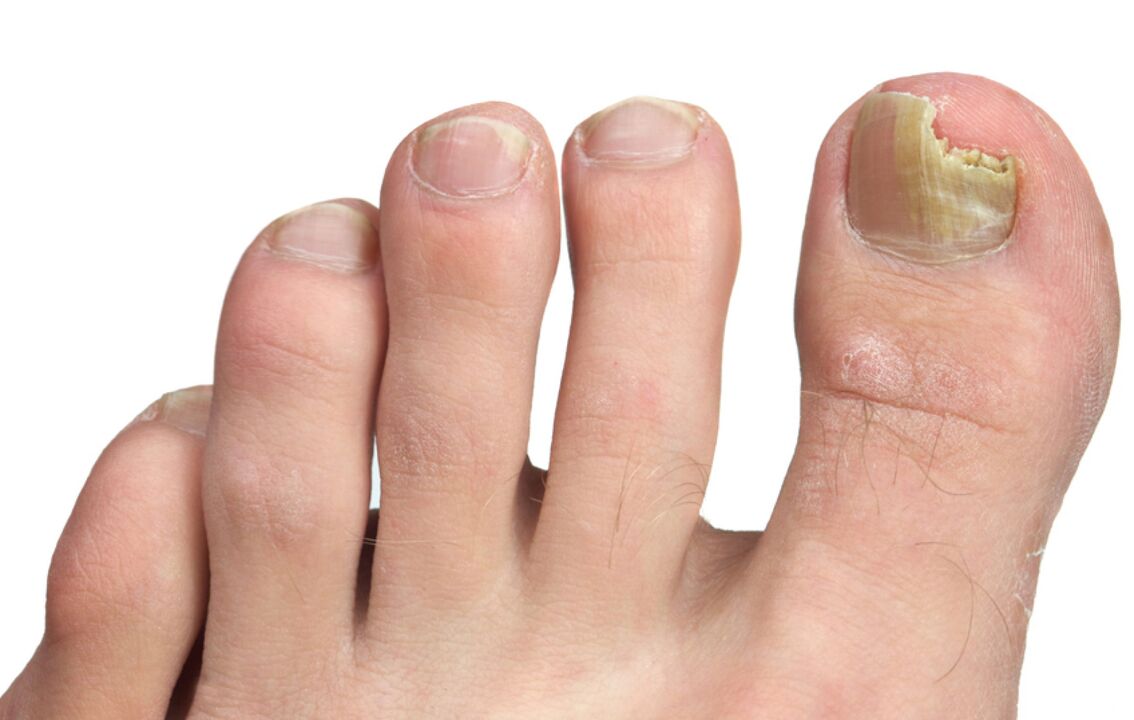
The feet affected by nail fungus can seem extremely uncomfortable to others, so the patient is forced to hide, which is especially difficult during the warm season. In addition, running onychomycosis causes complications.
What a dangerous disease
Many patients ’reluctance to see a doctor at an early stage or not recognizing the first symptoms of onychomycosis leads to a transition to a chronic form that can become ill throughout their lives. However, with normal immunity, the fungus "freezes" at a certain level, and any of the provocative factors mentioned above can re-transmit the disease into the active phase.
The following categories belong to the risk group for complications of fungal nail infections:
- Children under 12,
- pregnant,
- women who are breast-feeding
- people of the older generation.
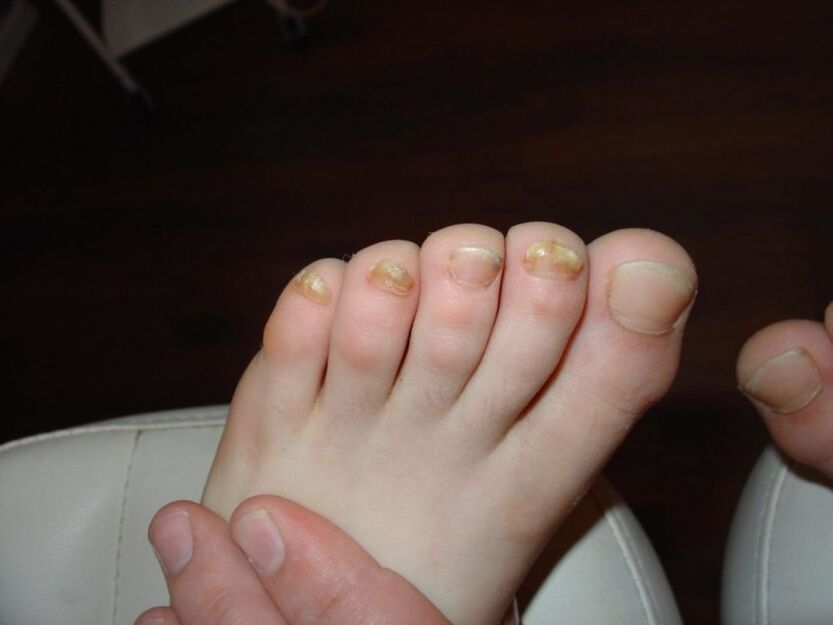
Due to the decrease in the body's defenses, the disease disappears rapidly in these individuals, leading to a further weakening of immunity and the following possible consequences:
- allergic reactions to bronchial asthma,
- worsening of the course of chronic diseases of the internal organs,
- poisoning the body due to the penetration of toxins into the blood,
- dysbacteriosis,
- appearance of new inflammatory foci on the skin,
- nervous system disorders, psychological problems.
Because nail mycosis refers to infectious diseases, not only the patient himself but all his personal belongings are a constant source of infection for others. If onychomycosis is detected in a woman during pregnancy, there is a risk that the unborn baby will be born prone to allergies.
Diagnostics
Fungal diseases of the skin and nails are treated by dermatologists or mycologists. Contact your clinic or dermatovenerology office for a consultation.
After interviewing the patient, the doctor can take a picture of the appearance and development of the disease. The following measures will help you make an accurate diagnosis and prescribe the most effective treatment:
- visual inspection of the affected nails with a Wood's ultraviolet lamp,
- inclusion of skin and nail pieces for examination,
- general blood and urine tests.
The biomaterial obtained from the scraping is sent to the laboratory, where it is examined under a microscope, which makes it possible to determine the fungal nature of the disease.
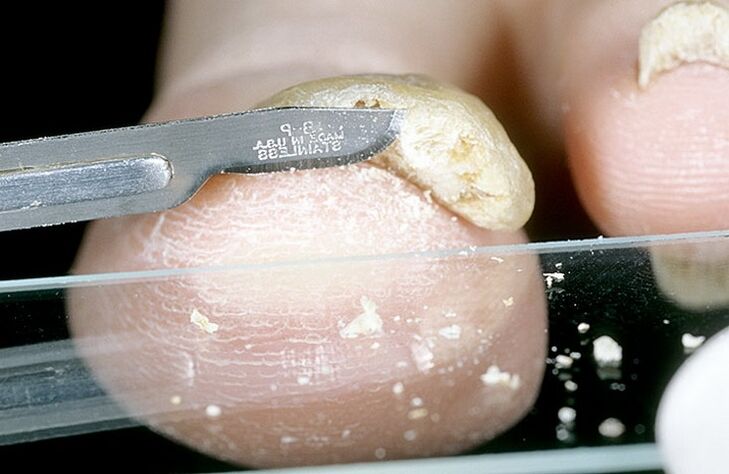
In order to clarify the type and strain of pathogenic microorganisms, fungal cultures are placed in culture medium and optimal conditions are created for their development. After 10-14 days, based on the type and shape of the colonies, not only the identification of the pathogen but also its response to the most common drugs can be determined.
PCR (polymerase chain reaction) is considered to be the fastest and most accurate method. The biomaterial is processed by special enzymes that allow the fungus to be studied at the DNA level. As a result, the type of pathogen is determined and its exact description is given.
Based on the above procedures, the patient makes a final diagnosis and an optimal regimen is developed to get rid of the fungus as soon as possible.

Treatment
Dermatologists only promise a positive prognosis for onychomycosis if the patient strictly adheres to all prescriptions and recommendations.
In most cases, complex treatments are performed, which include the use of external ointments, creams and varnishes, oral antifungal drugs, and alternative therapies.
Keratolytics are used to soften and remove the affected nail plate. You can also get rid of the manifestations of fungal infection with the help of special varnishes.
Oral antifungal antibiotics are prescribed in cases where the nail fungus is at an advanced stage or where there is a risk of developing a secondary infection that may be caused by pathogenic bacteria entering the affected areas.
You can speed up the healing process by using traditional healers at home. According to patients, the following procedures are most effective:
- baths with baking soda or herbal decoctions,
- apple cider vinegar lotion,
- compress with celandine tincture,
- ointments based on propolis and other apiculture products.
To kill pathogenic microorganisms, nails should be treated with essential oils of cinnamon, clove, pine, oregano or lemon before applying antifungal agents.
Many dermatology centers offer laser removal of the fungus from the nail. This procedure, which allows you to get rid of the affected nail plate quickly and painlessly, is done on an outpatient basis.
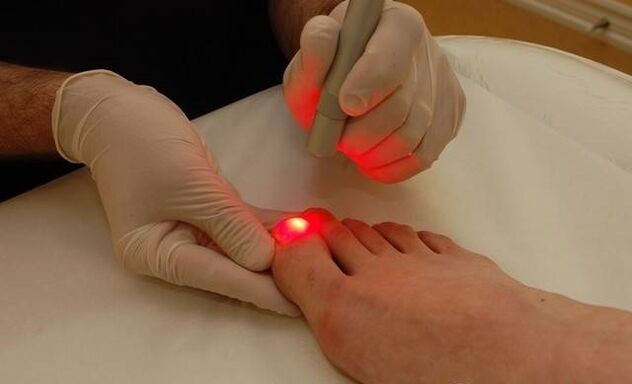
How to get mushrooms
Onychomycosis is an infectious fungal disease that is easily spread from person to person through household contact.
This is most often done like this:
- when walking barefoot in public places with high humidity - saunas, spas, gyms, swimming pools, beach,
- when trying on or wearing someone else's shoes or stockings
- through bed linen, towels, wipes, brushes and other personal items.
When visiting a manicure salon, care must be taken to disinfect the equipment, as in many cases the fungal infection is caused by the fault of unscrupulous workers in beauty salons.
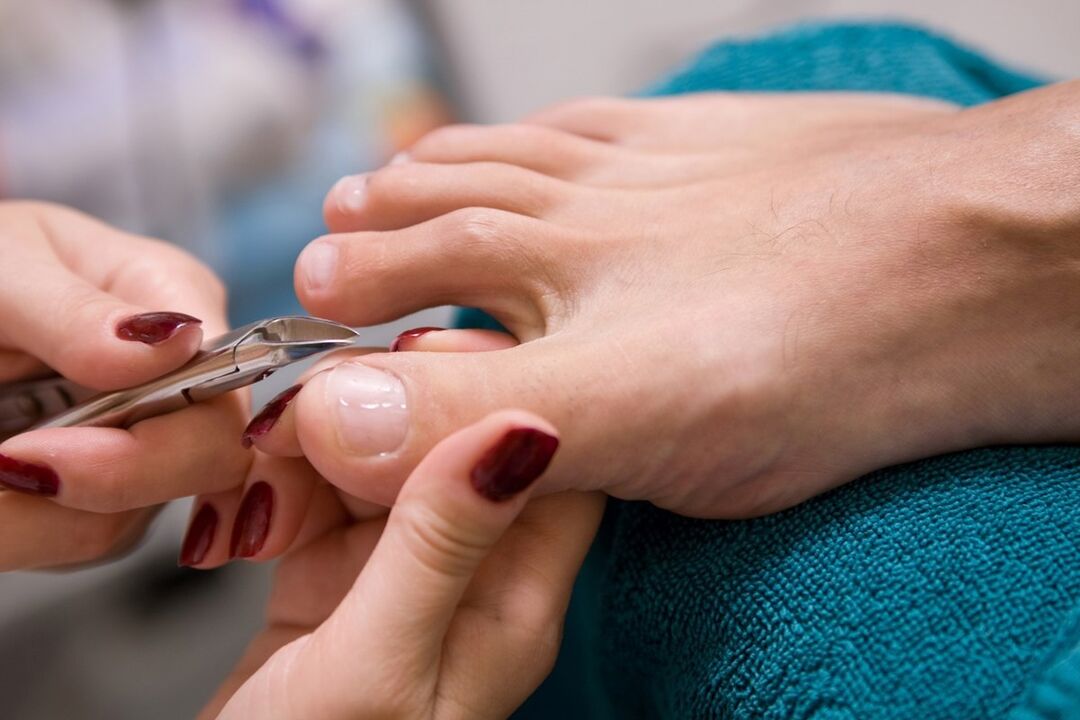
Prevention
In order to prevent the growth of pathogenic fungi, even when they get on your nails or skin, you need to take care of your health and strengthen your immune system by following these recommendations:
- Refuse bad habits.
- Stay fit.
- Spend more time outdoors.
- Balance your diet with foods that contain nutrients and vitamins.
- Observe personal hygiene.
- Cure all chronic diseases in a timely manner.
- Wear quality shoes and stockings that do not restrict or float your feet.
- Shoes used in the pool, gym or on the beach should be treated regularly with disinfectant.
If you find any incomprehensible lesions on your skin or nails, you may want to make an appointment with a dermatologist to start treatment as soon as possible and to get rid of the fungus as soon as possible.
























